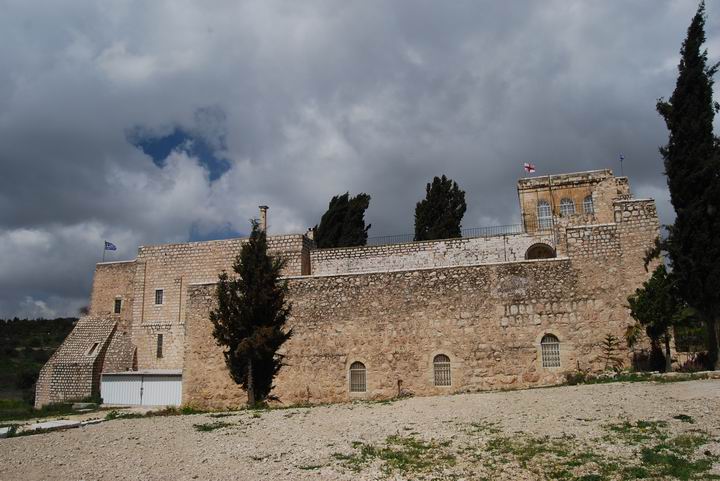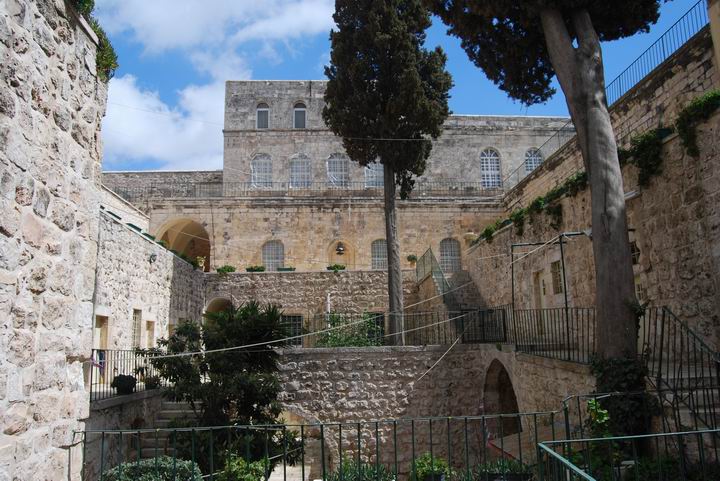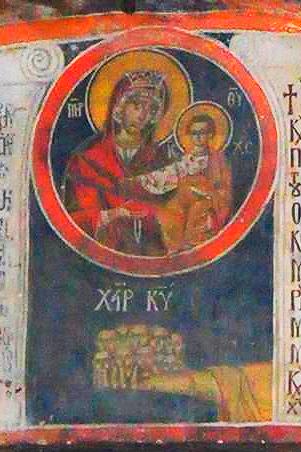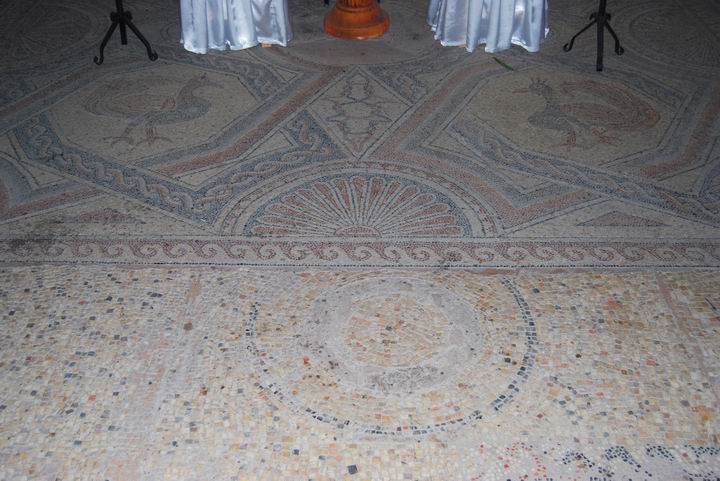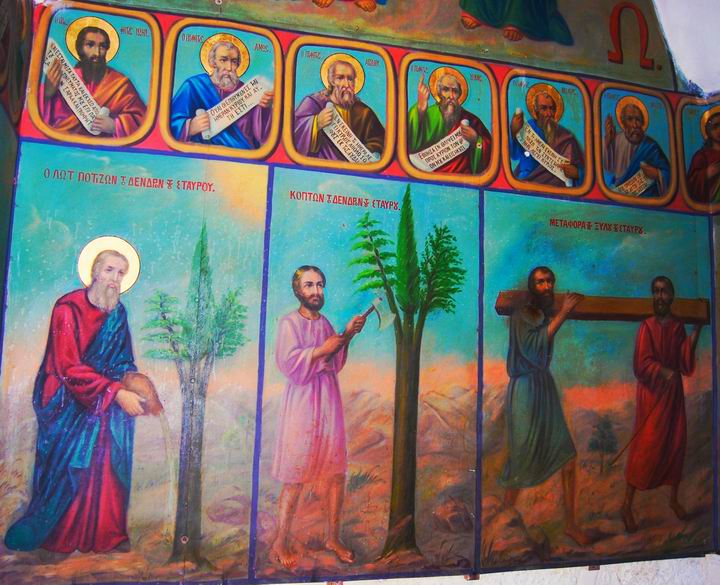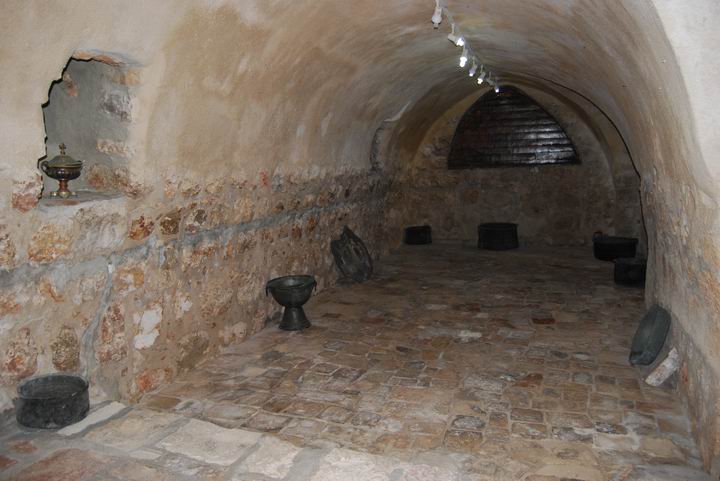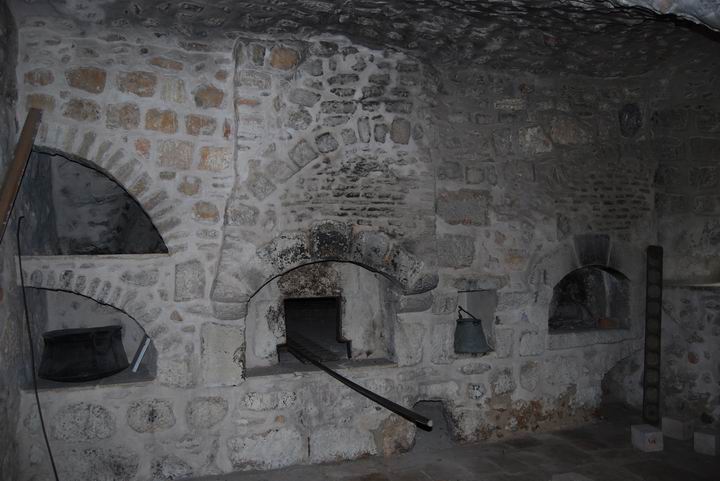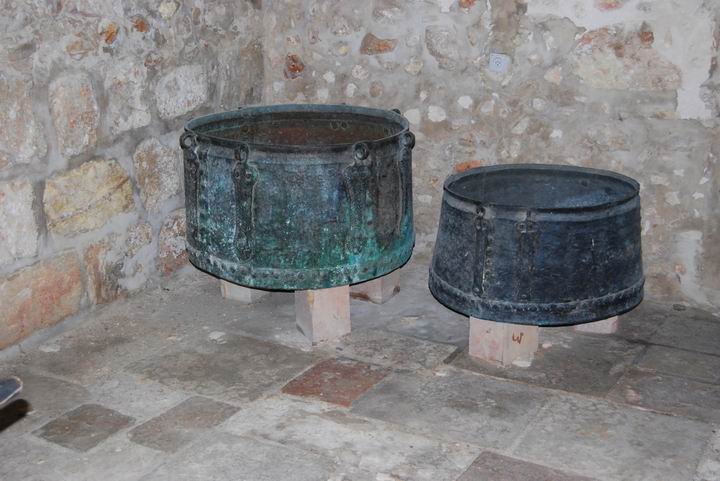A medieval Monastery located in the valley of the Cross. Here, according to tradition, grew the tree of the Cross.
Home > Sites > Jerusalem > Monastery of the Holy Cross
Contents:
Overview
Location
History
Tradition
Photos
* General view
* Court Yard
* Entrance to Church
* Church
* Holy Tree Room
* Halls
* Dining room
Etymology
Links
Overview
A Greek-Orthodox monastery, built as a fortress, located in the Rehaviah valley (Cross valley). According to tradition it is the site of the tree that was used to build the cross of the crucifixion.
John 19:25: “Now there stood by the cross of Jesus his mother, and his mother’s sister, Mary the wife of Cleophas, and Mary Magdalene”.
Location
The Monastery is located in a park south-east to the Israeli Museum and the Knesset (Israeli parliament). In ancient times this site, 3.5KM south west to the Christian quarter in the old city, was actually a remote and secluded site, which is typical of the Monasteries. Today, however, the area is bounded by one of the richer neighborhoods (Rehaviah, on its east side) and the important public and Government buildings (on its north-west side).
The access to the site is from a service road that starts at the junction of Harav-Herzog Blvd and Zalman-Shneur Rd (the lower left corner in the aerial view below). The tourist buses also stop at the junction of Herzog/BenZvi/Aza.
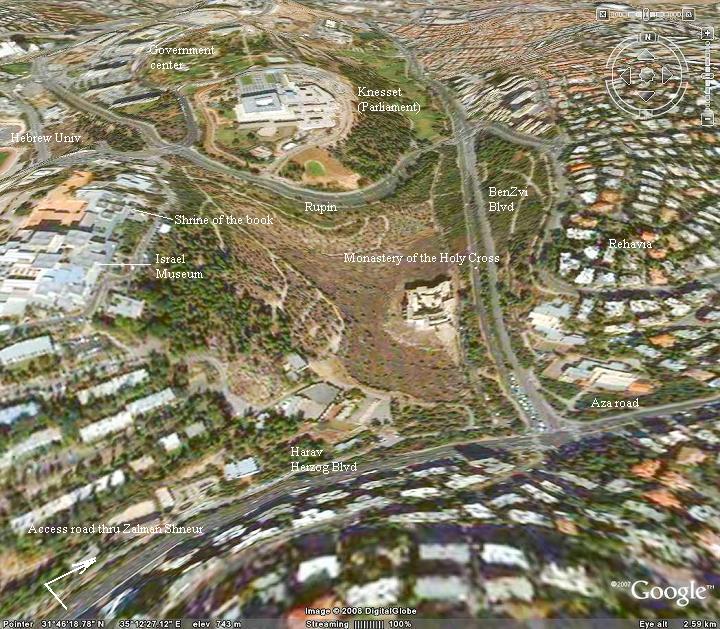
History
- Byzantine period:
The monastery was initially built in the Byzantine period, during the 5th century AD. It was repaired by Caesar Justinian in the mid 6th century. The Monastery was destroyed during the Persian invasion (614 AD). In 796 the Arabs butchered all the residing monks.
- Crusaders
The monastery was rebuilt in the 11th century by a Georgian Monk, and enjoyed better times during the times of the Crusaders. The site was a large center in the 13-14th century, and hosted a hundreds of Georgian monks, scholars and poets.
- Mamelukes
After the Crusaders left the city (1267 AD) the site was under the control of the Mamelukes, who added a mosque inside the complex. During the times of the Mamluk ruler Baibars (1260-1277) the Church was demolished and the monks removed, but were permitted to return on 1305 after pressure from Byzantine.
During the 16th century the Arabs demanded to convert it to a mosque, on the grounds of the existence of a mosque in the 13th century, but this attempt was blocked.
- Ottoman
At the end of the 17th century the Monastery changed control from the Georgians to the Greek-Orthodox church. The number of residents has decreased over the years to a few.
- Modern period
The Monastery is open to the public and is kept by a few resident monks. It is a popular visiting site for the Christian pilgrims who visit Jerusalem.
Tradition of the Tree:
The Holy tree, according to the tradition and the local paintings in the Monastery, was based on a triplet seeding (pine + cypress + cedar) that Abraham gave to Lot. Lot planted the tree at this site and watered it with waters he fetched from the Jordan river.
According to the Bible, Lot, the nephew of Abraham, was given a vineyard by his uncle. In Genesis 19, it is mentioned that Lot planted a vineyard near the city of Sodom and Gomorrah. This is seen as a symbol of Lot’s success and prosperity in his new home. The planting of the vineyard also reflects Lot’s acceptance of the gift from Abraham and his integration into the land of Canaan.
The story of Lot and his vineyard serves as a reminder of the generosity and kindness of Abraham, who welcomed his nephew and provided him with the means to establish a new life in a foreign land. It also highlights the importance of agriculture in the ancient Near East and the role of vines and vineyards in the economic and cultural life of the region.
The tree was later used to create the Holy Cross on which Jesus was crucified. A room inside the Monastery marks the site of the tree.
Painting above the entrance to the church:
Lot watering the Holy Tree
The cross was later buried in the grave of Jesus (Holy Sepulchre). Fragments of the cross were found by Helen, the mother of Emperor Constantine who discovered the vault in her visit (326 AD). They were transferred to Rome and are on display in “Santa Croce in Gerusalemme” (Church of the Holy Cross).
Photos:
(a) General view:
A general view of the monastery is seen from the south on the following photo. It is protected by walls and looks more like a fortress rather then a Holy place. The reason for these massive walls and the defensive design of the Monastery was to protect it during the hostile middle ages.
Within the complex is a square bell tower and a brown dome with a cross on the top.
Click on the photos to view in higher resolution…
A closer view of the Monastery, built in the 11th century. The entrance, through a low and narrow doorway, is on the south-east side (the right side of the photo below).
(b) Courtyard:
After entering into the western court yard, a door leads into an inner court.
The inner courtyard is seen below. Around the courtyard is a maze of rooms that served the monks. In its peak times the Monastery hosted hundreds of pilgrims and residents.
On top of the monastery is a square bell tower. This was built later, in the 19th century, and has two clocks on each side.
(c) Entrance to the Church:
This is the western entrance to the church. The bell tower is seen above.
On top of the entrance door (seen in the above photo) is the painting with Lot planting the Holy tree at this site and watering it with waters he fetched from the Jordan river. It was based on a triplet seeding (pine + cypress + cedar) that the Abraham gave to Lot. The tree was later used to create the Holy Cross on which Jesus was crucified.
(*) Thanks to R. Gale who corrected our error
The church is located in the center of the structure, on its eastern side. The door opens to a long entrance hall with doors to the Basilica on the left side.
(d) The Church:
This is the western side of the Church and its entrance door. The inscription above the right side of the door is Greek, and the left side has an identical inscription in Georgian script. They tell about the renovations held here in 1644, sponsored by Leontanian, by the heads of the Monastery – Nikephoros Mousis and Gregorios Neophylos and Gerasimos Menas.
A closer look at the door. To the right of the door is a painting of King Solomon; he is holding a scroll from the “Book of wisdom of Solomon”. Below the Greek inscription, is a painting of an unidentified bearded man.
Between the inscriptions is a small painting, which is detailed on the right side.
Within a red circle are Mary and infant Jesus. The Greek initials “IC XC” around Jesus stands for “Jesus Christ”.
The initials “MPOY” around Mary stands for “Mother of God”. Just below the red circle the Greek initials – meaning the “hand of God”. Under the initials is a hand of God holding a collection of skulls of Monks.
The photo below shows the view of the basilica, with the altar hidden behind the septum (partition).
In the center of the floor, close to the septum, are the remains of an ancient mosaic floor. The mosaic incorporates pictures of animals, plants and geometric patterns. The dark stains on the floor, as we are told, are blood stains of the monks that were butchered here in 796 AD by an Arab mob.
Another view of the eastern side, and the cavity under the dome.
Some of the stands and panels inside the church are seen in the next photos. They cast a special Holy sensation, as in all of the Greek Orthodox churches.
On the right (south) side of the hall is a chair reserved for the Greek Patriarch, seen below. Above the chair (but not seen in the photo) is a fresco depicting the departure of Elijah on a chariot of fire, while his pupil the prophet Elisha is observing from the Jordan river and picking up his mantle (as per 2 Kings 8).
Another view of the grand septum – the partition between the church hall and the main altar. On the right pillar, seen on the right side of the photo below, is a fresco (wall painting) showing Jesus.
On the top of the left pillar, facing the hall, is a painting of the angel Gabriel who announced the birth of Jesus to Mary; facing the septum is the Patriarch Yehuda.
The left pillar shows Mary, holding infant Jesus. The Greek initials IC XC around Jesus stands for “Jesus Christ”.
The right panel closest to the door has Paul on the left side (Peter is on his left but hidden in this photo).

Another fresco of saints on one of the pillars.
(e) Room of the Holy Tree:
A door on the left side of the church leads to a narrow hall, which turns into the holiest place – the site of the Holy tree. The photo below shows the small room, with paintings that tell the story of the tree.
The highlight of the room is located under the table with the red cloth: a small hole within a decorated bronze plate marks the place where the holy Tree once stood.
On the walls of the room are several painted panels. The left panel shows (from left to right) Lot escaping the destruction of Sodom, Abraham giving lot the triplet seeding, and Lot planting the tree.
The center panel starts from Lot who waters the Holy Tree from the waters of the Jordan river. Many years later it is cut down, and its wood are hauled by two men to the crucifixion site.
The wood is brought to the crucifixion site, and Jesus is hammered to the cross, with the Roman soldiers watching on the left side and Virgin Mary and Mary Magdalene on the right background.
The last panel, just above the place of the Holy tree, shows Jesus crucified on the cross with the two women witnesses.
In the narrow hall are additional paintings and displays, such as the crucified Jesus with Mary and Mary.
(f) Dwelling rooms:
The monks lived in the rooms around the church. The photo below shows one of these rooms, located on the ground level on the western side.
(g) Dining Room and Kitchen:
The kitchen and dining room are located on the second floor, on the eastern side of the church. The stoves of the kitchen are seen below, where the food was prepared for the monks and guests of the Monastery.
The cooking pots in the kitchen.
The dining room is seen below, with long marble tables.
Through this hole the water was fetched from the well.
Etymology
-
Matzlevah -in Hebrew – “making of a cross”. The name is based on the Hebrew root word “Tzlav” = cross. The name is not an official Hebrew word and is used only in this context; it may have been converted from its Arabic name.
- Emek Hamatzlevah – in Hebrew – valley (Emek) of the making of the cross
- Rehaviah – in Hebrew – God (-iah) is wide (Rahav). A residential area east to the valley of the cross.
- Knesset – The Israeli parliament, located north to the valley of the cross. Means “assembly” in Hebrew – based on the root word “Kaness” – to assemble.
Links
- Ariel Encyclopedia [1978, in Hebrew] Term: “Mazleva” pp. 4739-4769. A comprehensive description of the site.
- List of patriarchs
- Greek initials – info page in BibleWalks.com
- BibleWalks – trees and bushes of the Holy Land
This page was last updated on Feb 11, 2023 (update the order of the sections, added details on Lot’s tree)
Augusta Victoria<—previous Jerusalem site–<<< All Sites >>>—> St. Francis Monastery

